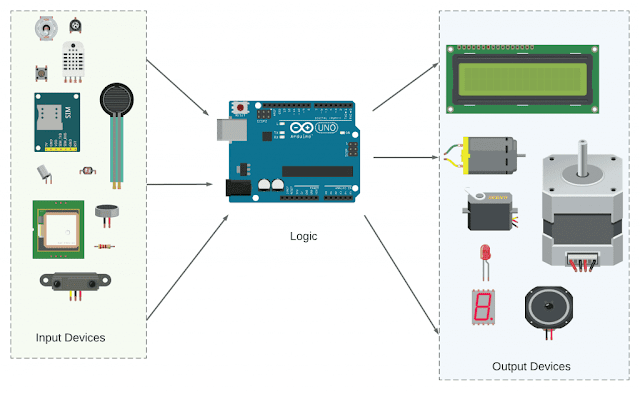Arduino Introduction
One of the most well-liked electronic prototyping platforms available today for learning and using microcontrollers is Arduino. This is so that anyone may utilize the ATMEGA328 microcontroller thanks to the Arduino developers' simplification of its hardware and programming.
Even if you've never built or programmed an electronic circuit before, the Arduino will allow you to construct rather complex projects without having a thorough understanding of microcontrollers. The Arduino's level of abstraction has made it significantly simpler for people to learn electronics engineering and programming.
WHAT IS AN ARDUINO?
The majority of microcontrollers require the inclusion of extra parts, such as crystal oscillators, voltage regulators, capacitors, and resistors, in order to create projects.
Since it functions right out of the box, the Arduino eliminates the need to connect external components. This enables users to concentrate more on creating prototypes and designing circuits than on getting the microcontroller to function.
Arduino Board
A development board for the ATMEGA328 microcontroller is called the Arduino. On a single PCB, the Arduino has all the electronic parts required to support the ATMEGA328. Input/output pins, a USB port for connecting the Arduino to a computer, and a 9V DC power connector are additional essential features.
Although there are many various varieties of Arduino boards, the Arduino Uno is the most widely used:
The hardware of the Arduino is open-source, meaning anyone can include it into a design without violating any licensing agreements or patents. The numerous third-party Arduino "clones" and accessories available on the market serve as evidence of the open-source nature of the Arduino.
How do you program Arduino?
It is incredibly simple to write Arduino code, which is one of the reasons the Arduino is so well-liked. The most common programming languages for microcontrollers are C and assembly, both of which are challenging to learn.
Based on the far more user-friendly C/C++ programming language, Arduino is significantly simpler to learn and utilize. You can learn how to program it using a wealth of internet tools and tutorials. Our video course, The Ultimate Guide to Arduino, is a fantastic resource. We teach all of the fundamental and sophisticated Arduino programming techniques that will enable you to construct any project.
The abundance of libraries for the Arduino programming language is one of its best features. Libraries are collections of programs that have routines to perform routine activities like reading an accelerometer's data or outputting a PWM signal to drive servos. Because the code is already written for you, libraries make it much simpler to interact with external sensors and modules on the Arduino.
WHAT FUNCTION CAN THE ARDUINO PERFORM?
Due to the versatility of the Arduino as an electronics development platform, a wide range of input and output devices can be connected to it. Button, switch, temperature, GPS, magnetometer, PIR, ultrasonic range finder, and many more types of input devices could be used.
Servo, DC motor, LCD display, LED, buzzer are a few examples of output devices:

Examples of the Arduino's input and output devices
The Arduino can be programmed to process inputs from any input device and output a result through certain output conditions defined in an Arduino program.
What is the best way to choose an Arduino?
There is a great deal of Arduino development boards on the market, but determining which one will work best for a given application can be difficult. By looking at what your purpose is and what you hope to accomplish using the Arduino, the below table can assist you in deciding.
I hope this article has a clearer understanding of what Arduino is, its many uses, and how you can pick the Arduino that works for you!
Please be aware that the comments below have not answered all of your questions. If you've got additional questions about your particular project, be sure to leave a comment.










No comments: